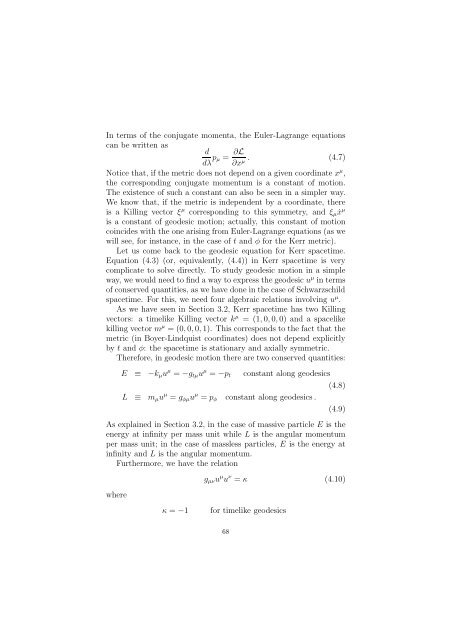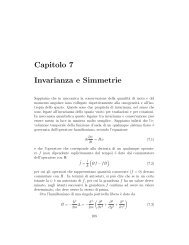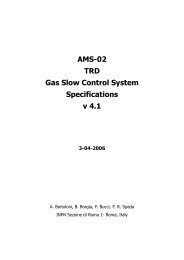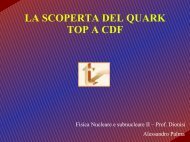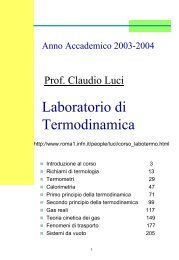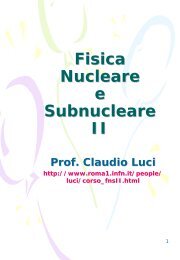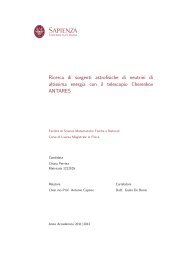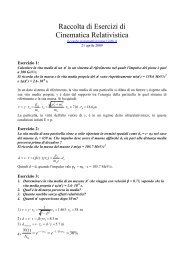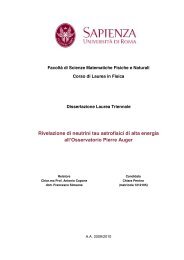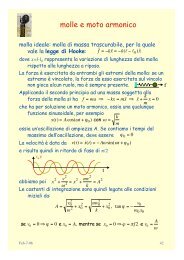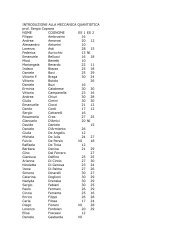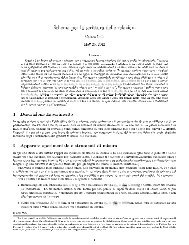Create successful ePaper yourself
Turn your PDF publications into a flip-book with our unique Google optimized e-Paper software.
In terms <strong>of</strong> <strong>the</strong> conjugate momenta, <strong>the</strong> Euler-Lagrange equations<br />
can be written as<br />
d<br />
dλ p µ = ∂L<br />
∂x . (4.7)<br />
µ<br />
Notice that, if <strong>the</strong> <strong>metric</strong> does not depend on a given coordinate x µ ,<br />
<strong>the</strong> corresponding conjugate momentum is a constant <strong>of</strong> motion.<br />
The existence <strong>of</strong> such a constant can also be seen in a simpler way.<br />
We know that, if <strong>the</strong> <strong>metric</strong> is independent by a coordinate, <strong>the</strong>re<br />
is a Killing vector ξ µ corresponding to this symmetry, and ξ µ ẋ µ<br />
is a constant <strong>of</strong> geodesic motion; actually, this constant <strong>of</strong> motion<br />
coincides with <strong>the</strong> one arising from Euler-Lagrange equations (as we<br />
will see, for instance, in <strong>the</strong> case <strong>of</strong> t and φ for <strong>the</strong> <strong>Kerr</strong> <strong>metric</strong>).<br />
Let us come back to <strong>the</strong> geodesic equation for <strong>Kerr</strong> spacetime.<br />
Equation (4.3) (or, equivalently, (4.4)) in <strong>Kerr</strong> spacetime is very<br />
complicate to solve directly. To study geodesic motion in a simple<br />
way, we would need to find a way to express <strong>the</strong> geodesic u µ in terms<br />
<strong>of</strong> conserved quantities, as we have done in <strong>the</strong> case <strong>of</strong> Schwarzschild<br />
spacetime. For this, we need four algebraic relations involving u µ .<br />
As we have seen in Section 3.2, <strong>Kerr</strong> spacetime has two Killing<br />
vectors: a timelike Killing vector k µ =(1, 0, 0, 0) and a spacelike<br />
killing vector m µ =(0, 0, 0, 1). This corresponds to <strong>the</strong> fact that <strong>the</strong><br />
<strong>metric</strong> (in Boyer-Lindquist coordinates) does not depend explicitly<br />
by t and φ: <strong>the</strong> spacetime is stationary and axially sym<strong>metric</strong>.<br />
Therefore, in geodesic motion <strong>the</strong>re are two conserved quantities:<br />
E ≡ −k µ u µ = −g tµ u µ = −p t constant along geodesics<br />
(4.8)<br />
L ≡ m µ u µ = g φµ u µ = p φ constant along geodesics .<br />
(4.9)<br />
As explained in Section 3.2, in <strong>the</strong> case <strong>of</strong> massive particle E is <strong>the</strong><br />
energy at infinity per mass unit while L is <strong>the</strong> angular momentum<br />
per mass unit; in <strong>the</strong> case <strong>of</strong> massless particles, E is <strong>the</strong> energy at<br />
infinity and L is <strong>the</strong> angular momentum.<br />
Fur<strong>the</strong>rmore, we have <strong>the</strong> relation<br />
where<br />
κ = −1<br />
g µν u µ u ν = κ (4.10)<br />
for timelike geodesics<br />
68


